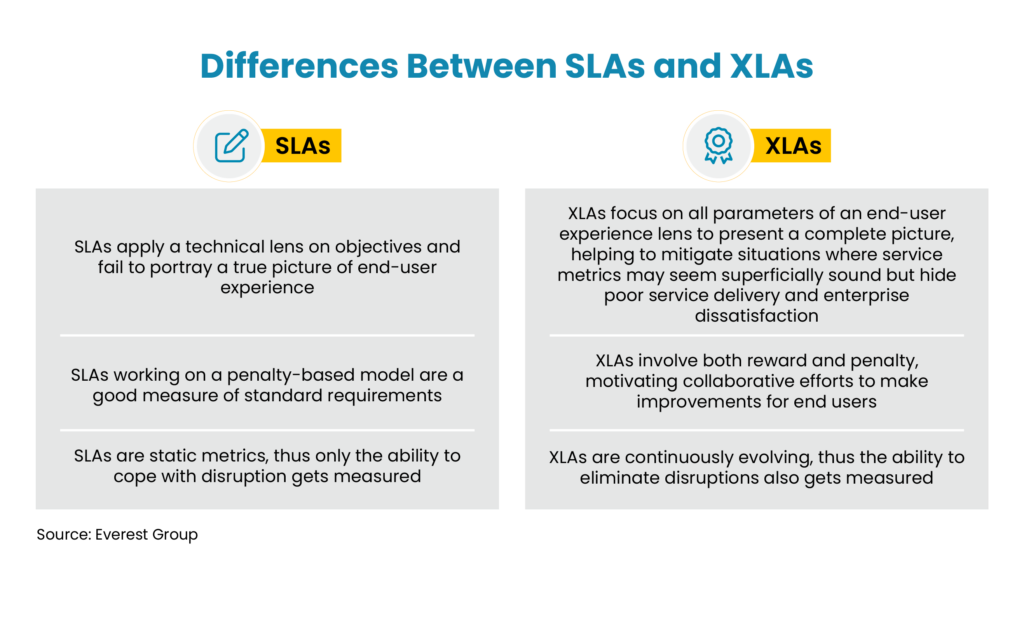In brief:
- Restaurants and retail depend on IT support more than any other industry, but they are also among the most dissatisfied with their IT support team.
- To provide effective support, restaurant help desks need more than generalized IT knowledge – they need to be deeply familiar with the unique IT challenges that confront the industry and multi-location business models.
- The right strategy for successful help desk outsourcing for restaurants includes having an end goal in mind, clearly defining service desk scope and expectations, creating a location strategy that supports your store footprint, and more.
The restaurant industry is no stranger to the rapid proliferation of technology across business processes which is transforming industries across the board. The last few years have witnessed brands making significant investments in restaurant technology solutions to improve customer experiences and revamp backend processes, with IT budgets at restaurant companies doubling in recent years to now account for 7-10% of their revenue, Bank of America’s 2023 State of the Restaurant Industry report found.
Today, the tech infrastructure required to maintain smooth restaurant operations and deliver seamless customer experiences includes point of sale (POS) systems, kitchen display systems, online ordering platforms, digital payment solutions, inventory management tools, data security solutions, and more. To be effective, help desk agents must be deeply familiar with the unique IT challenges faced by the restaurant industry and provide seamless, multi-channel assistance with wide coverage, proactive maintenance, compliance with data privacy regulations, and the ability to quickly scale and adapt to differing requirements across multiple store locations.
The goal: rapid problem resolution at every store to help restaurant brands maintain operational continuity and customer satisfaction.
Why is effective restaurant help desk support so challenging?
Even multi-billion-dollar businesses are no longer able to gather in-house help desk resources to meet their IT support needs internally, as the ongoing tech labor shortage leaves most IT departments stretched thin and inundated with a record number of requests. This often leads to understaffed in-house help desks delivering inconsistent service, inadequate coverage, outdated knowledge bases, and limited documentation and metrics.
Help desk outsourcing for restaurants can mean the difference between minimizing operational disruptions during peak service hours and facing regular POS outages and costly downtime. While impact can vary based on store size and volume, stores lose about $855 per hour from a POS outage in a single store. The average store experiences over 80 hours of unplanned downtime every year, with 87% having to wait for up to four hours for support, Digi’s latest industry downtime study found.
Today, help desk is one of the most outsourced IT functions, with 50% of IT organizations outsourcing service desk operations, according to Computer Economics’ 2023 IT Outsourcing Statistics report. More than half (55%) of help desk and desktop support processes are currently outsourced – a higher percentage than other IT functions.
And 91% of organizations that outsource their help desk expect to increase or retain their investment, the report found.

Yet without the right strategy, industry expertise, and understanding of the challenges of multi-location support, help desk outsourcing can struggle to achieve the right results for restaurant operators.
Restaurants and retail depend on IT support more than any other industry, but they are also among the most dissatisfied with their IT service experience, HappySignals’ 2023 Global IT Experience Benchmark Report found. This dissatisfaction is often because different store technologies are typically supported by different vendors, meaning store workers end up having to raise multiple tickets – spending more time on hold or speaking to various IT support teams.
It is also because help desk providers with generalized IT knowledge but no industry experience struggle to provide effective support for stores that typically have different configurations, equipment models, tech setups, network conditions, and levels of tech proficiency among staff.
Restaurant and retail end users lose an average of 3 hours and 13 minutes of working time during IT incidents, the HappySignals report found.
Outsourced help desk services for restaurants: 10 simple steps to achieve value for your business
Outsourced help desk solutions, when executed properly, can help restaurants overcome the challenges discussed above, while focusing internal IT teams on core business functions. Below we touch on some key steps to successfully outsource your support services.
1. Start with an end goal in mind
Too many IT outsourcing projects fall apart because restaurant operators don’t begin with an end goal in mind. This can result in a lack of focus on crucial elements like enhancing customer experience, reducing downtime, or streamlining operational processes, while also making it challenging to establish metrics for success.
Identifying your business drivers for IT outsourcing – and aligning your leadership team and outsourcing provider behind them – ensures your service desk delivers the value you need.
Whether your goal is scalability, improved service consistency, expanded coverage and language skills, a higher strategic focus for IT, or another business driver, defining a clear vision from the start is key to accurately measuring your provider’s performance and setting the right expectations for the business.
Learn more about the business drivers that should define your restaurant help desk outsourcing strategy by downloading our new guide, “Help Desk Outsourcing: A Step-by-Step Guide to Success for the Restaurant Industry.”
2. Clearly define scope of help desk outsourcing services
Most restaurants that are still running their help desk operations internally do not necessarily have a clear understanding of their business requirements when it comes to ticket volumes, hours of operation, and staffing levels. As part of your outsourcing selection process, make sure to invest time in thoroughly defining scope and expectations for your service desk provider.
Key considerations to be kept in mind for this analysis include:
- Coverage hours required
- Having a single, convenient touchpoint for seamlessly resolving all IT and operational issues in a store.
- Ensuring your provider has the right tools and automation capabilities to resolve high-volume, frequent issues rapidly to avoid repeated disruptions, which can eat into already thin margins in restaurant operations.
- Robust service-level agreements (SLAs) complemented by experience-level agreements (XLAs) for creating a more holistic approach to performance measurement and service management.

Learn all the considerations to keep in mind for defining service desk scope and expectations, and more detailed insights on each consideration, by downloading our new guide, “Help Desk Outsourcing: A Step-by-Step Guide to Success for the Restaurant Industry.”
3. Define your location strategy based on your business footprint
How a vendor’s location fits into your business footprint matters to outsourcing success. Today, organizations rank physical proximity as the biggest factor when considering outsourcing, the Computer Economics report found, while low cost is the lowest-ranked priority.

Organizations are now more likely to choose an IT partner within the same geographical region – even with lower cost options available in more distant locations – due to reduced operational challenges, easier management of data residency issues, and compatibility of language and time zone.
Latin America, over the last couple of decades, has emerged as a frontrunner for providing the right talent to staff U.S.-based operations with significant labor arbitrage.
Besides top nearshoring hubs such as Costa Rica and Colombia providing quality tech talent and real-time communication, Latin America’s multilingual nature is also key to restaurant IT support. By combining strong English fluency with the ability to easily service the large percentage of Spanish-speaking employees at U.S. store locations, nearshore providers ensure issues are communicated accurately to the service desk and instructions for achieving speedy resolution are clear.
Why else does LATAM offer a better alternative?
Learn more about why enterprises are increasingly turning to geographically close outsourcing – and key benefits for restaurant operators – by downloading our new guide “Help Desk Outsourcing: A Step-by-Step Guide to Success for the Restaurant Industry.”
4. Don’t fall for the myth of cost per ticket
When evaluating help desk companies, restaurant operators need to consider more than just cost. Solutions that look attractive on the surface like cheap Level 1 ticket servicing often hide ugly surprises, like poorly trained staff and frequent ticket escalations, leading to longer resolution times, increased downtime, and a negative impact on restaurant operations during critical service hours.
For a low cost-per-ticket model to work, organizations need high volumes, extremely standardized systems, and low service delivery expectations. Engaging a generalized outsourcer with bottom-of-the-barrel pricing is unlikely to deliver the specialized service and multi-location business experience needed to successfully support restaurant operations and diverse restaurant technology solutions – over-emphasizing cost reduction at the expense of customer satisfaction.
Unfortunately, that sets your service desk up for frequent service disruptions, increased customer complaints, and inefficiencies that can damage brand reputation.
Help Desk Outsourcing: A Step-by-Step Guide to Success for the Restaurant Industry

To learn the six other critical steps for successful help desk outsourcing – and receive more detailed insights on the four steps above – download “Help Desk Outsourcing: A Step-by-Step Guide to Success for the Restaurant Industry.”
What’s included in “Help Desk Outsourcing: A Step-by-Step Guide to Success for the Restaurant Industry”
Download our Restaurant Help Desk Outsourcing Guide to learn everything you need to know to maximize the value of your outsourced help desk provider for seamless restaurant IT operations. Our 10-step roadmap expands on the above steps and more, including:
- Challenges for providing effective restaurant help desk support
- Determining help desk support levels and escalations beyond Level 1
- Automation and AI capabilities that help you build a more proactive service desk
- Choosing the right help desk model and location strategy
- How a unified care model can help seamlessly resolve all IT and operational issues across store locations
- Experience-level agreements vs. service-level agreements – how to measure metrics and customer experiences
- What to look for in a restaurant IT support partner
- And more!
Want to learn more about how outsourced help desk providers can support your restaurant operations? Schedule a consultation with our restaurant industry and help desk leaders today! Or visit our resource center to learn more about restaurant IT trends, strategies, and success stories.




